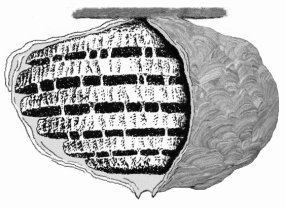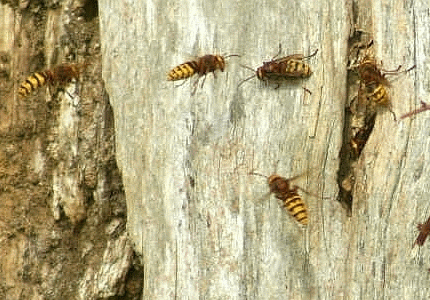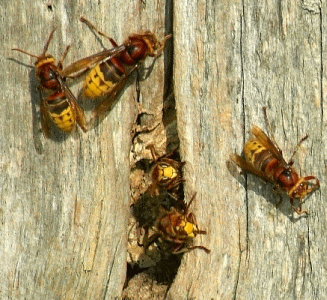
Consulting Entomologist

Tel/Fax: 01275 854224
E-Mail: [email protected]
Site Guide
Site Search
Home Page
Career Page
Insect Files
- Contents
- Bug Index
- The World of Bugs
- Classification of Bugs
- Insect Identification
- Insect Fossils
- Insect Body-parts
- Micro View of Bugs
- Insect Life Cycles
- Insect Defences
- Insects of Nailsea
- Pesticide Safety
- Bibliography
Shortcut to the main groups of insects and other arthropods...
Bug Rhymes & Poems
Links
Shop
Payments (credit/debit card)
Social Wasps & Hornets |
Class: Insecta Order: Hymenoptera |
| Warmer spring weather brings
many insects out of their winter hibernation, including queen wasps. In early spring, I often see several of these large insects flying along the eaves and walls of my own house in search of possible nesting sites. Wasps are no real bother to us at this time of year, but why not read on in preparation for the summer 'swarms' . . . . . . | |
|
The social wasps and hornets (also known as 'yellow-jackets' in North America) comprise the family Vespidae and belong to the order of insects called Hymenoptera, which also includes the bumblebees, honeybees, ants, sawflies and ichneumon-flies. Most members of the Vespidae have a worker caste and form annual colonies which last for just one summer. The queens (or egg-laying females) are much larger than the workers, but both queens and workers have a poison-sac and retractable sting at the tip of the abdomen - as everyone knows, they can inflict a very painful sting when disturbed and agitated! | |
|
The bright yellow and black striping of wasps is a warning pattern to prospective predators, such as birds, that the insect is venomous and best left alone. This yellow and black colouring is copied, as a form of mimicry, by many insects, which in reality are perfectly harmless and merely take advantage of the deterrent effect of appearing 'wasp-like'. These harmless wasp-mimics include many of the hover-flies, often seen hovering near flowers on warm sunny days, and several day-flying moths and beetles that also visit flowers to feed on pollen and nectar. The largest European social wasp, usually 30-40 mm long, is the hornet (Vespa crabro). This impressive insect occurs in Britain, but is relatively uncommon here and largely confined to the south. The wasp most often encountered in the British Isles is the smaller common wasp (Vespula vulgaris). The queens of this and other social species hibernate through the winter in secluded holes in fences or trees, or sometimes indoors - often hanging by their jaws from rafters, curtains and other rough surfaces. Queens emerge from hibernation in spring and start building their nests in underground holes, hollow trees or in the wall and roof cavities of buildings. The nest is more or less spherical or slightly cone-shaped and made from splinters and shavings of wood chewed into a greyish or yellowish paper-like material. By late summer, as the colony grows, a nest may reach the size of a football or even larger. It usually consists of several horizontal tiers of 'paper' combs, in which the larvae or grubs are reared, protected and hidden inside several outer layers of 'paper'. The whole structure is usually suspended from an overhead support or from the ceiling of the nest cavity on a stout 'paper' stalk, with an entrance hole at the bottom (more wasp & nest images). |
|
|
The diagram on the right illustrates the nest of a social wasp with the outer covering partly cut away to show the internal tiered arrangement of horizontal brood combs. The brood cells are on the underside of each comb and open downwards. New combs of brood cells are added as the colony grows larger, with each new tier built below the previous one and attached to the one above by a number of slender 'paper' stalks. By the end of summer, a fully formed nest may have up to about eight tiers. |
 |
|
The first eggs laid by the queen develop into workers and these wasps gradually take over the nest-building and feeding activities in the colony. The workers forage continuously throughout the summer, searching for caterpillars and other insects which they capture and paralyze with their sting. The immobilized prey is carried back to the nest, chewed and then regurgitated to feed the developing wasp grubs. However, the adult wasps themselves are entirely vegetarian, living on nectar, fruit and any sweet liquid they can find. Towards the end of summer, wasp colonies produce males and females (young queens) instead of more workers. After these wasps have left the nest on their mating flights, the colony quickly declines and eventually dies out during the autumn as food becomes scarce. Only the young mated queen wasps survive through the winter, ready to start new nests in the following spring. Many of the caterpillars and other insects preyed upon by wasps are garden pests, and in this respect wasps are beneficial in helping to regulate pest populations and prevent potential damage to garden plants. Thus, wherever possible, it is sensible to leave wasp nests undisturbed in order to encourage the natural control of pests, and perhaps reduce the need for insecticide treatments. This will save money (garden insecticides are not always cheap to buy), but more importantly it will help protect wildlife and your garden environment from unnecessary exposure to pesticide contamination. 
 Workers of the European hornet, Vespa crabro, active around their nest entrance in a hollow tree Photo: Brion James © Wasps of course can become a nuisance, particularly in late summer when they increasingly feed on fruit and other sweet materials. They show most aggression when disturbed around the nest-site, and nests inside buildings and garden sheds, or close to well used entrances and walk-ways, may become especially troublesome. Eventually, these nests may have to be destroyed because of the nuisance and risk they cause to people living or passing nearby. When wasps, particularly the larger species of hornets, are busy gathering woody material for nest-building, they sometimes chew and damage the timbers of fences and buildings, and strip the bark of trees causing die-back of branches and young shoots. They can be discouraged from chewing the wood of fences and buildings by a fresh coat of paint or wood preservative, but damage to trees is more difficult to prevent and, again, often the only solution is to locate and destroy the nest. However, unless you are experienced in dealing with wasps, never attempt to destroy a colony yourself. If you find a nest, keep well away. There can be several thousand workers in a fully-formed colony and ALL OF THEM CAN STING! It is far more sensible, and safer, to call in an expert. Contact your Local Council or a reputable pest-control firm or consultant. | |
|
MORE ON WASPS & THEIR ALLIES Order Hymenoptera <<< HERE >>> |
| <<< TOP | (use the back button on your web browser to return to the previous page) | TOP >>> |